Related Research Articles
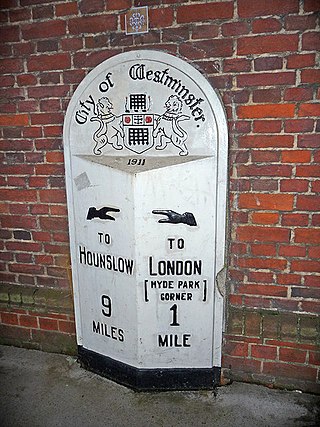
The mile, sometimes the international mile or statute mile to distinguish it from other miles, is a British imperial unit and United States customary unit of distance; both are based on the older English unit of length equal to 5,280 English feet, or 1,760 yards. The statute mile was standardised between the Commonwealth of Nations and the United States by an international agreement in 1959, when it was formally redefined with respect to SI units as exactly 1,609.344 metres.

The yard is an English unit of length in both the British imperial and US customary systems of measurement equalling 3 feet or 36 inches. Since 1959 it has been by international agreement standardized as exactly 0.9144 meter. A distance of 1,760 yards is equal to 1 mile.
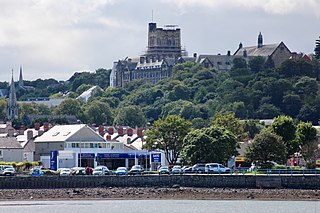
Bangor is a cathedral city and community in Gwynedd, North Wales. It is the oldest city in Wales. Historically part of Caernarfonshire, it had a population of 15,100 at the 2021 census. Landmarks include Bangor Cathedral, Bangor University and Garth Pier. The Britannia and Menai Suspension bridges connect the city to the Isle of Anglesey.

The Kingdom of Gwynedd was a Welsh kingdom and a Roman Empire successor state that emerged in sub-Roman Britain in the 5th century during the Anglo-Saxon settlement of Britain.

The carucate or carrucate was a medieval unit of land area approximating the land a plough team of eight oxen could till in a single annual season. It was known by different regional names and fell under different forms of tax assessment.
Rhun ap Maelgwn Gwynedd, also known as Rhun Hir ap Maelgwn Gwynedd, sometimes spelt as 'Rhûn', was King of Gwynedd. He came to the throne on the death of his father, King Maelgwn Gwynedd. There are no historical records of his reign in this early age. A story preserved in both the Venedotian Code and an elegy by Taliesin says that he waged a war against Rhydderch Hael of Alt Clut and the kings of Gododdin or Manaw Gododdin. The small scattered settlement of Caerhun in the Conwy valley is said to be named for him, though without strong authority. Rhun also appears in several medieval literary stories, as well as in the Welsh Triads. His wife was Perwyr ferch Rhûn "Ryfeddfawr" and their son was Beli ap Rhun "Hîr".

Aberffraw is a village and community on the south west coast of the Isle of Anglesey in Wales. The village is 9 miles from the island's county town, Llangefni, and is located on the west bank of the Afon Ffraw. The community includes Soar and Dothan. Located near the A4080 and the nearest rail station is Bodorgan.
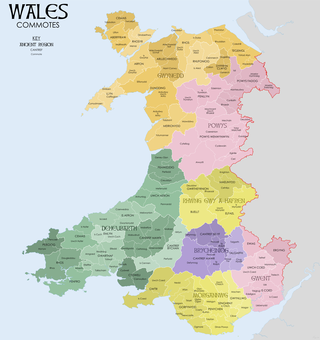
A commote was a secular division of land in Medieval Wales. The word derives from the prefix cym- and the noun bod. The English word "commote" is derived from the Middle Welsh cymwt.

Cyfraith Hywel, also known as Welsh law, was the system of law practised in medieval Wales before its final conquest by England. Subsequently, the Welsh law's criminal codes were superseded by the Statute of Rhuddlan in AD 1284 and its civil codes by Henry VIII's series of Laws in Wales Acts between 1535 and 1542.

Bleddyn ap Cynfyn, sometimes spelled Blethyn, was an 11th-century Welsh king. King Harold Godwinson and Tostig Godwinson installed him and his brother, Rhiwallon, as the co-rulers of Gwynedd on his father's death in 1063, during their destruction of the kingdom of their half-brother, king Gruffydd ap Llywelyn. Bleddyn became king of Powys and co-ruler of the Kingdom of Gwynedd with his brother Rhiwallon from 1063 to 1075. His descendants continued to rule Powys as the House of Mathrafal.
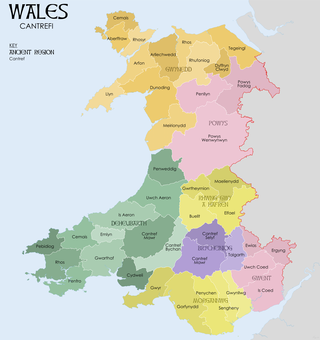
A cantref was a medieval Welsh land division, particularly important in the administration of Welsh law.

Powys Fadog was the northern portion of the former princely realm of Powys. The princes of Powys Fadog would build their royal seat at Castell Dinas Brân, and their religious center at Valle Crucis Abbey. Some of its lordships included those of Maelor, Mochnant, Glyndyfrdwy, Yale, and Bromfield and Yale. Following the division of Powys, their cousin branch, the princes of Powys Wenwynwyn, would build Powis Castle.
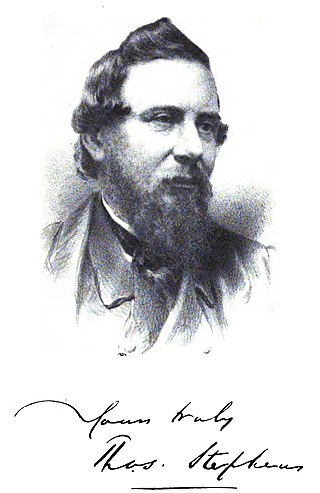
Thomas Stephens was a Welsh historian, literary critic, and social reformer. His works include The Literature of the Kymry (1849,1876), Madoc: An Essay on the Discovery of America by Madoc ap Owen Gwynedd in the Twelfth Century (1858,1893), and Orgraff yr Iaith Gymraeg (1859), as well as a number of prize-winning essays presented at eisteddfodau between 1840 and 1858. He was the first Welsh historian and literary critic to employ rigorous scientific methods, and is considered to have done more to raise the standards of the National Eisteddfod than any other Welshman of his time. Stephens also figured prominently in efforts to implement social, educational and sanitary reforms both locally in Merthyr Tydfil and more broadly throughout Wales.

St Cristiolus's Church, Llangristiolus is a medieval church near the village of Llangristiolus, in Anglesey, north Wales. The village, about 1 mile (1.6 km) from the building, takes its name from the church. Reputedly founded by St Cristiolus in 610, the present building dates from the 12th and 13th centuries. Alterations were made in the 16th century, when the large east window in Perpendicular style was added to the chancel – a window which has been described by one guide to the buildings of north Wales as "almost too big to fit" in the wall. Some restoration work took place in the mid-19th century, when further windows were added and the chancel largely rebuilt.

St Caian's Church, Tregaian, also known as St Caean's Church, Tregaean, is a small medieval church dating from the 14th century in Anglesey, north Wales. It is dedicated to St Caian, a Christian from the 5th or 6th century about whom little is known. The building contains a late 14th-century east window and a late 15th-century doorway. The churchyard contains the grave of William ap Howel, who died in 1581 at the age of 105, leaving over forty children between the ages of 8 and 89 and over three hundred living descendants.

St Beuno's Church, Aberffraw is a 12th-century parish church in Anglesey, north Wales. A church was established in Aberffraw in the 7th century by St Beuno, who became the abbot of Clynnog Fawr, Gwynedd. St Beuno's may have been used as a royal chapel during the early Middle Ages, as the princes of Gwynedd had a court in Aberffraw. The oldest parts of the church date from the 12th century, although it was considerably enlarged in the 16th century when a second nave was built alongside the existing structure, with the wall in between replaced by an arcade of four arches. Restoration work in 1840 uncovered a 12th-century arch in the west wall, which may have been the original chancel arch or a doorway to a western tower that has been lost. The church also has a 13th-century font, some memorials from the 18th century, and two 18th-century copper collecting shovels.

The conquest of Wales by Edward I took place between 1277 and 1283. It is sometimes referred to as the Edwardian conquest of Wales, to distinguish it from the earlier Norman conquest of Wales. In two campaigns, in 1277 and 1282–83, respectively, Edward I of England first greatly reduced the territory of Llywelyn ap Gruffudd, and then completely overran it, as well as the other remaining Welsh principalities.
The maenor was a gathering of villages in medieval Wales. In North Wales the word maenol was used for a similar, but not identical, idea.
The Black Book of Chirk is a 13th-century Welsh-language manuscript, known also as the Chirk Codex. It is Peniarth 29 of the National Library of Wales, and deals with legal and historical matters. It contains also an elegy addressed at Llywelyn ap Iorwerth; king of Wales. This poem was probably written by his grandson Llywelyn ap Gruffudd who lived in the 13th century.

Aneurin Owen was a Welsh historical scholar.
References
Citations
- ↑ Owen (1841), Book II, Ch. XVII, §2.
- ↑ Owen (1841), Book III, Ch. VI, §11.
- ↑ Owen (1841), Book II, Ch. XII, §2.
- 1 2 3 4 5 6 7 Owen (1841), Book II, Ch. XVII, §5.
- 1 2 3 4 5 6 7 8 Owen (1841), Book II, Ch. XVII, §6.
- ↑ Roche (1998), p. 25.
- 1 2 3 4 5 Owen (1841), Book II, Ch. XII, §1.
- 1 2 Lewis (1913), p. 42.
- 1 2 3 Wade-Evans (1909), p. 339.
- 1 2 3 4 5 Owen (1841), p. 81.
- ↑ Williams (1869), p. 500.
- 1 2 3 4 5 Wade-Evans (1909), p. 344.
- ↑ Owen (1841), Book II, Ch. XVII, §7.
- ↑ Owen (1841), Book II, Ch. XVII, §8.
- ↑ Owen (1841), Book II, Ch. XVII, §9.
- ↑ Owen (1841), Book II, Ch. XVII, §10.
- ↑ Owen (1841), Book II, Ch. XVII, §11.
- 1 2 Owen (1841), Book II, Ch. XVII, §12.
- ↑ Owen (1841), Book II, Ch. XVII, §13.
- ↑ Jones (2007), note 5.
Bibliography
- Lewis, Timothy (1913), A glossary of mediaeval Welsh law, based upon the Black book of Chirk, Manchester: University Press.
- Owen, Aneurin, ed. (1841), "The Venedotian Code", Ancient Laws and Institutes of Wales; Comprising Laws Supposed to be Enacted by Howel the Good, Modified by Subsequent Regulations under the Native Princes prior to the Conquest by Edward the First: And Anomalous Laws, Consisting Principally of Institutions which by the Statute of Ruddlan were Admitted to Continue in Force: With an English Translation of the Welsh Text, to which are Added A few Latin Transcripts, Containing Digests of the Welsh Laws, Principally of the Dimetian Code, London: Commissioners on the Public Records of the Kingdom . (in Welsh) & (in English)
- Roche, John J. (1998), The Mathematics of Measurement: A Critical History, London: Athlone Press, ISBN 0-387-91581-8 .
- Wade-Evans, Arthur (1909), , Oxford: Clarendon Press.
- Wade-Evans, Arthur (2007), "The Laws of Hywel Dda: Harleian MS 4353 (V) with emendations from Cleopatra A XIV (W), ca. 1285", in Jones, Mary (ed.), Celtic Literature Collective, retrieved 1 February 2013.
- Williams, Jane (1869) [Republished at Cambridge by Cambridge University Press in 2010], A History of Wales: Derived from Authentic Sources, ISBN 978-1-108-02085-5 .